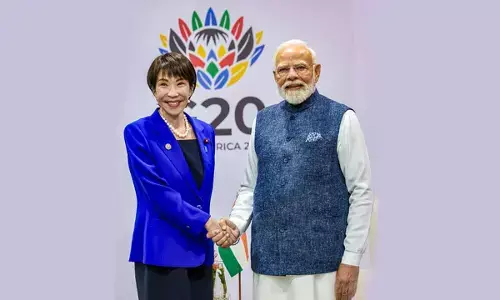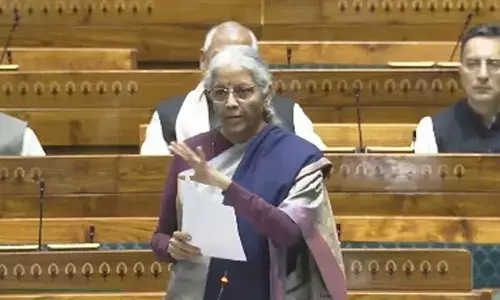Ghantasala The playback legend

Ghantasala Venkateswara Rao is so significant among the Telugu speaking lovers of music that even after four decades of his demise, his music continues to sway people cutting across regions and age groups. He was the lead singer in Telugu films for over two decades between 1950 and 1973 singing for every major actor.
Today is the 41st death anniversary of Ghantasala Venkateswara Rao (December 4, 1922 –February 11, 1974)
Ghantasala Venkateswara Rao is so significant among the Telugu speaking lovers of music that even after four decades of his demise, his music continues to sway people cutting across regions and age groups. He was the lead singer in Telugu films for over two decades between 1950 and 1973 singing for every major actor.
As a singer and composer, he was considered the very definition for music during his life time and after. His songs have imparted a never-to-be-obliterated sheen to the films of the two top stars of the times, ANR and NTR. Besides, he also sang many songs for the upcoming heroes of the 60s and 70s like Krishna, Sobhan Babu and Kantha Rao.
Devotional songs like ‘Raamuni Avatharam, Raghukula Somuni Avathaaram’( Bhookailas - 1958),’Jaya Krishna Mukunda Muraari’ ( Panduranga Mahatmyam - 1957), ‘Vaathapi Ganapathim Bhaje’ ( Naagula Chavithi), ‘Raaraa Krishnayya Raara Krishnayya’ ( Ramu), ‘Seshasaila Vaasa Sri Venkatesa’(Venkaeswara Mahaatmyam) are all numbers not only familiar but very dear to listeners even today.

‘Deva Deva Dhavalachala Mandira’, ‘Mahesa Paapa Vinaasa’ ‘ Neela Kandharaa Deva’ on Lord Shiva from ‘Kaala Hastheeswara Mahatyam’( 1954) could be heard from the precincts of many a Shiva Temple every day. Incidentally the main role in the film was played by the Kannada thespian Dr Raj Kumar. His renditions from Venkatesa Karaavalambam evoke instantaneous feelings of piety.
‘Seshasailavasa Sri Venkatesa’ was filmed on Ghantasala himself, performing with his limited orchestra in the very Sanctum Santorum at Tirumala sitting bore the Lord, as a humble offering to Him! Non filmi devotional numbers like ‘Namo Venkatesa’, ‘Edu Kondala Sami Ekkadunnavayya’ penned by poets like Ravulaparthi Bhadri Raju world have also been extremely popular. Perhaps Ghantasala has no parallel as one who composed great music for over 100 films simultaneously flourishing as a lead singer in films.
.jpg)
In all, he sang more than 13,000 songs, a majority of them being in Telugu films. Some of the greatest hits in Telugu Cinema like ‘Keelu Gurram’( 1949), ‘Paathala Bhairavi, ‘(1951), Maya Bazaar’, ( 1957) ‘Lava Kusa’( 1963), ‘Pandava Vanavasam’ ( 1965) and ‘Gundamma Katha’ (1962) were by Ghantasala as music director.
Some of the toughest numbers which pose a challenge to any singer like ‘Rasika Raja Taguvaaramu Kaama’ (Jaya Bheri – 1959 – a raga malika) and ‘Siva Sankaree, Sivaananda Lahari’ (Jagadeka Veeruni Katha – 1961 – Raag: Kaanada) were recorded in a highly embellishing taste and perfection by Ghantasala.
The Syama Dandakam ‘Manikya Veena Mupalalayanthi’ from the film ‘Mahakavi Kalidaasu’(1960) was also one such rare compositions. Quite interestingly all these songs were composed by the music director Pendyala Nageswara Rao. Ghantasala Venkateswarara Rao was born at Choutapalle village in Krishna District on December 4.
Patrayani Seetha Rama Sastry was his first Guru in music before he joined the Maharaja College of Music in Vizianagaram to qualify for his Sangeetha Vidwan Certificate. It was Samudrala Raghavacharya (popular as Senior Samudrala), the already established script writer and lyricist in films, who helped Ghantasala to find his way into Telugu films. Ghantasala’s wife hailed from the same village as that of Samudrala. His first film as a music director in films was ‘Mana Desam’, (1949), which was incidentally the first film of NT Rama Rao as an actor.

Noted Telugu Poet Karunasri’s (Jandhyala Papayya Sastry) ‘Pushpavilaapam’ was immortalised in the voice of Ghantasala. The long poem is about insensibility of human beings in their treatment and attitude towards beautiful flowers. His rendition of the ‘Bhagavad Gita’, God’s own treatise for humanity, in a concise form could be surmised as the ultimate in his musical pursuit of over three decades.
Each of the hundred plus slokas is accompanied by a rendition in simple Telugu explaining the meaning of the poem. Bhagavad Gita, recorded just months before his demise must have been for his own metaphysical fulfillment in the saga of his musical journey. He performed outside India on several trips to the US, the UK and Germany enthralling his avid fans and other music lovers.
Ghantasala, with his rare skills and erudition, brought a mark of his own in rendering the Telugu ‘Padyam’. Rendering padyam’s in films till the advent of Ghantasala’s style were more akin to the prevalent style from stage plays with unduly stretched out ragas and rather opaque and confusing pauses. Ghantasala brought in his own measured style of rendering a ‘padya’.
Pathos had its newer meanings when rendered by Ghantasala. ‘Bommanu Chesi Pranamu Posi Aadevu neekidi Vedukaa….Gaaradi Chesi Gundenu Kosi Navvevu ee Vintha Chaalika’ (Devatha), ‘Sudugaali Lona Deepam Kadavaraku Veluguna’ (Jeevitha Chakram), ‘Malliyalaara, Maalikalaara Mounamuga Vunnara’ (Nirdoshi) are a couple of sad songs the listeners are fond of.
Life’s irreversible and inscrutable hard realities are revealed through Ghantasala’s voice in songs with philosophical content. ‘Jagame Maya… Brathuke Maaya’ and ‘Kala Idanee Nijamidanee Teliyadule Brathukinthenule’ (Devadasu), ‘Kalimi Nilavadoo Lemi Migaladoo Kalakaalam Oka Reethi Gadavadoo’ (Rangula Raatnam) speak of the inevitability of the happenings in human life.
Ghantasala recorded songs as playback singer for the movies under several popular composers – S Rajeswara Rao, Pendyala Nageswara Rao, M S Viswanathan, K V Mahadevan, Adi Narayana Rao, Master Venu, T V Raju, T Chalapathi Rao, Shankar Jai Kishan, Susarla Dakshina Murthy, Galipenchala Narasimha Rao and others.
Thanks to the golden years for music in Indian films when he lived, Ghantasala could sing songs that fit into practically every genre- romantic, pathetic, motivational and philosophical and so on. His songs had indisputably made the onscreen performances of actors further richer.
Because of his dedicated learning of classical music, he could effortlessly articulate his voice as required to different Sruthi and Sthayi variations. His clarity, punctuation, stress and intonation have been sources of great inspiration to emulate by aspiring singers till now.
The Indian government released a postage stamp and to celebrate Ghantasala's work in 2003. He is the first movie singer-composer of the south to be accorded this honour. Also, in a similar gesture, a postal stamp on Ghantasala was released in the US in 2014, thanks to the initiative by the North American Telugu Society (NATS) in collaboration with Telugu Literary and Cultural Association (TLCA) in New York.The Government Music College in Vijayawada is named after Ghantasala.
He was the Aasthana Vidwan (the singer laureate) for the Tirumala Tirupati Devasthanams for sometime in the 70s. He tried his hand (rather unsuccessfully) as a producer of films for a couple of films—‘Sontha Vooru’ (1958) and ‘Bhakta Raghunath’ (1960). He died on February 11, 1974. Even a day prior to his death he recorded a song for a documentary ‘Bhadrachala Ramadasu Vaibhavam’.
By:Rajagopal Tiruvayapati




















